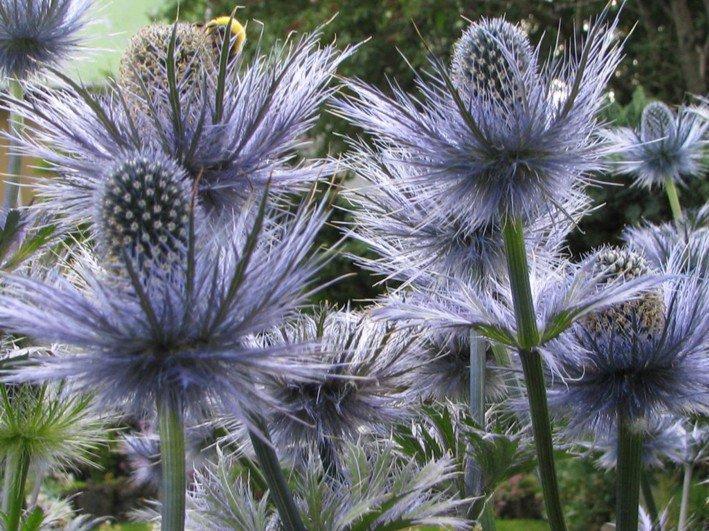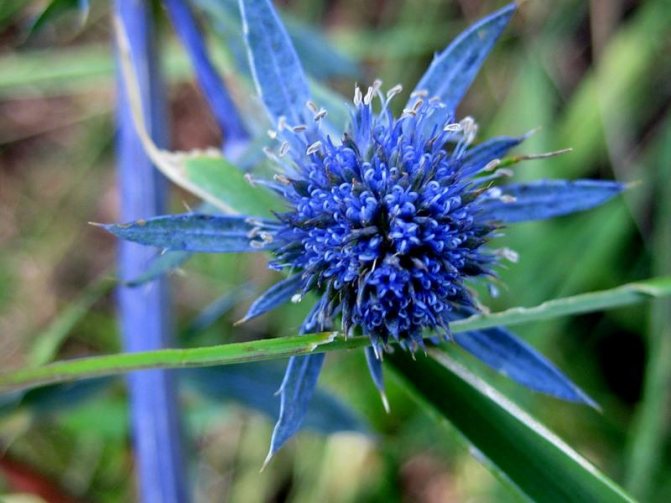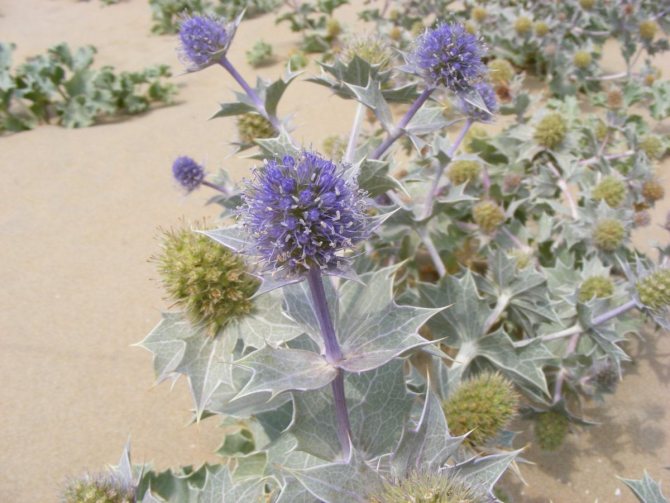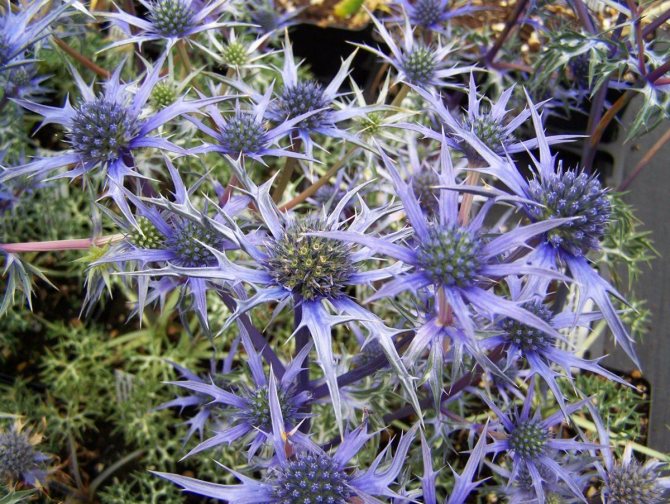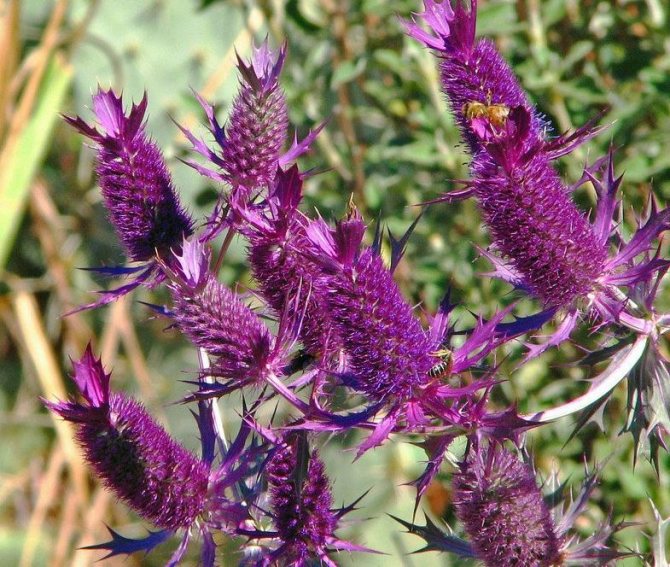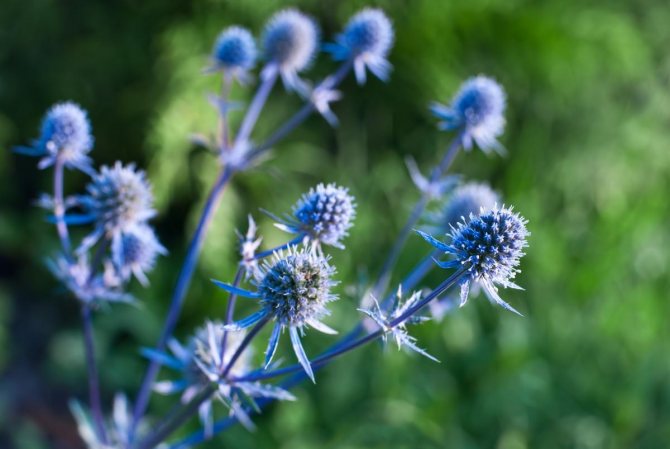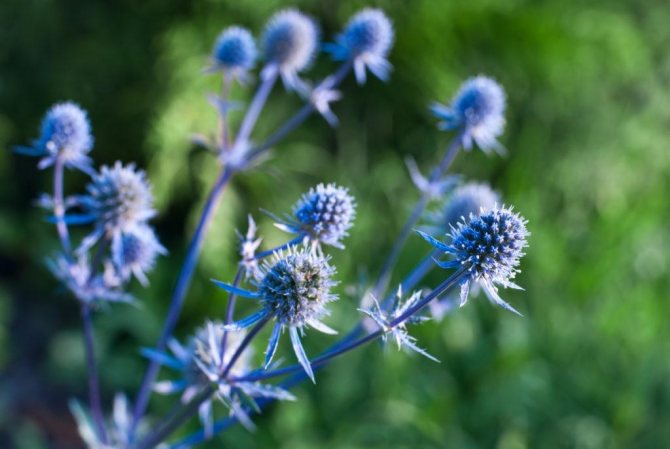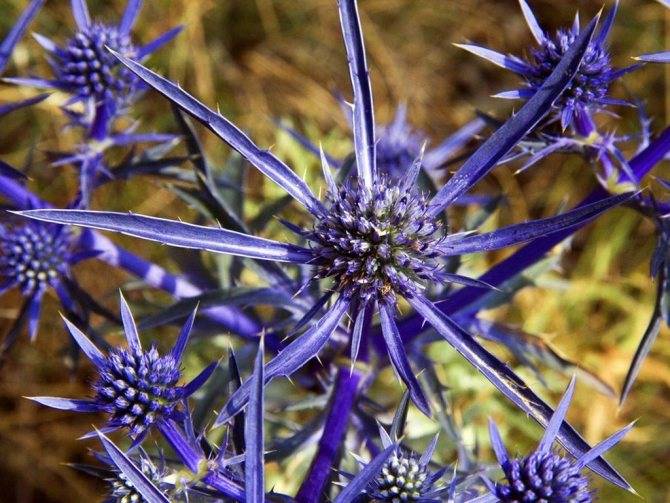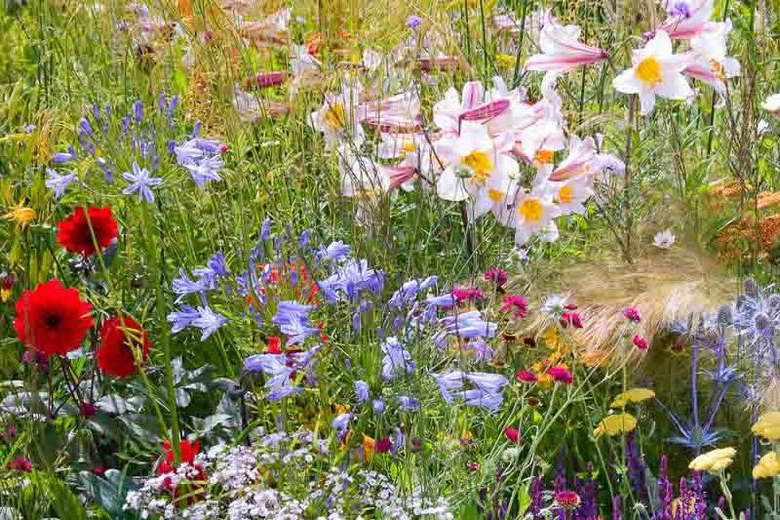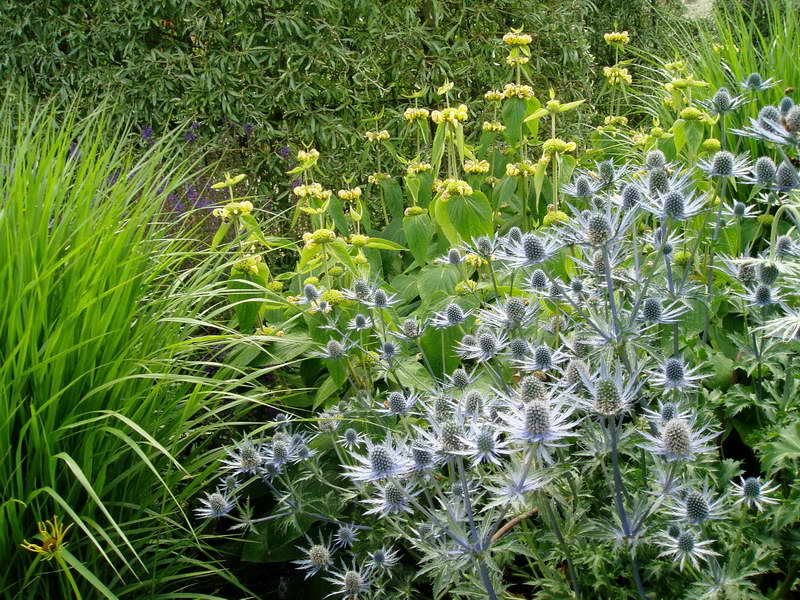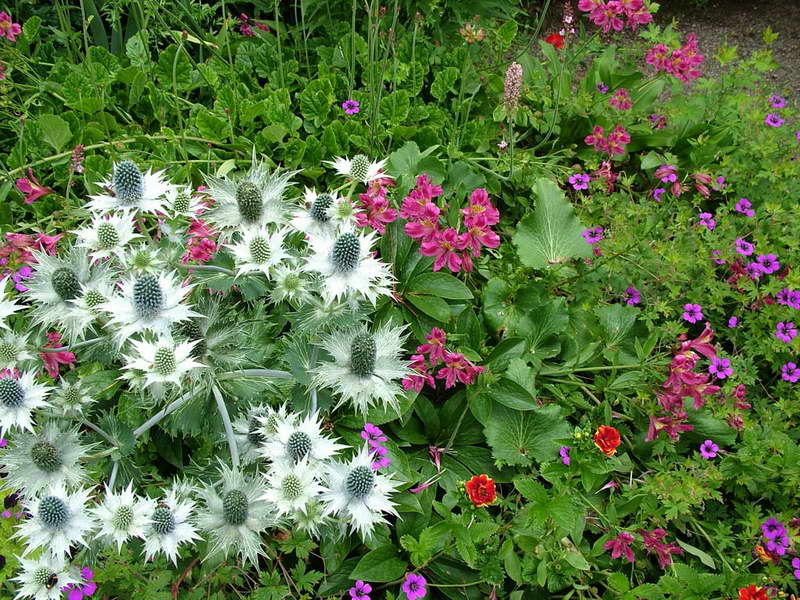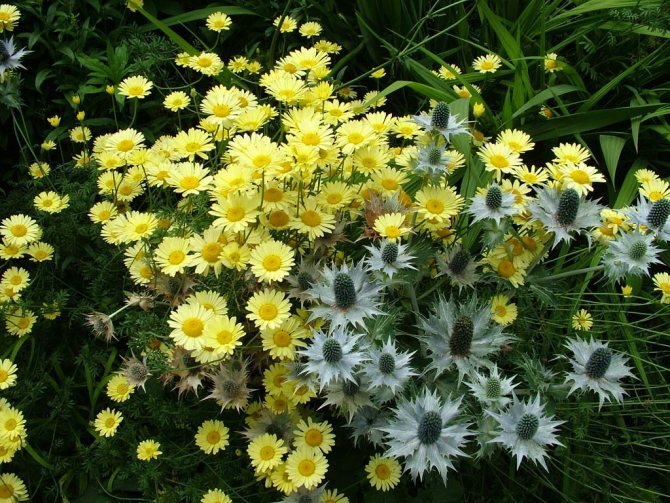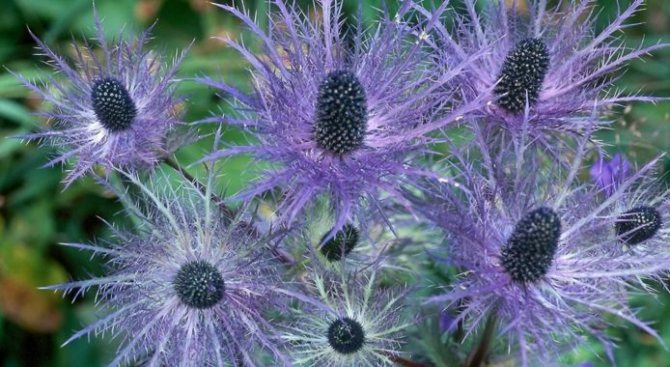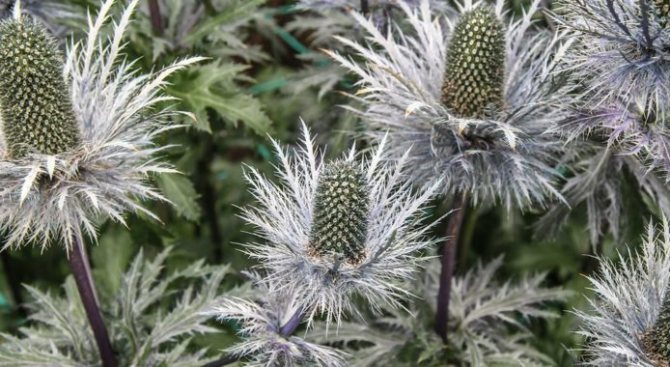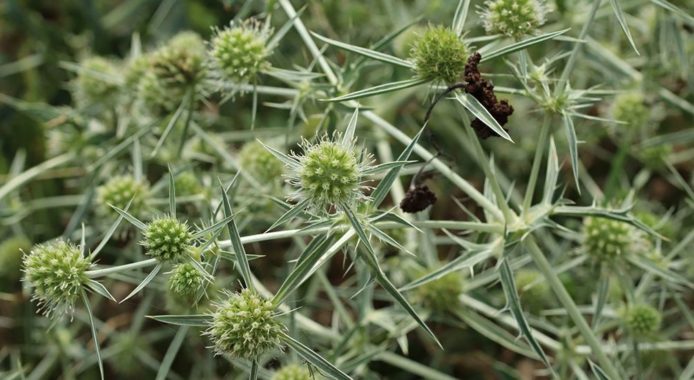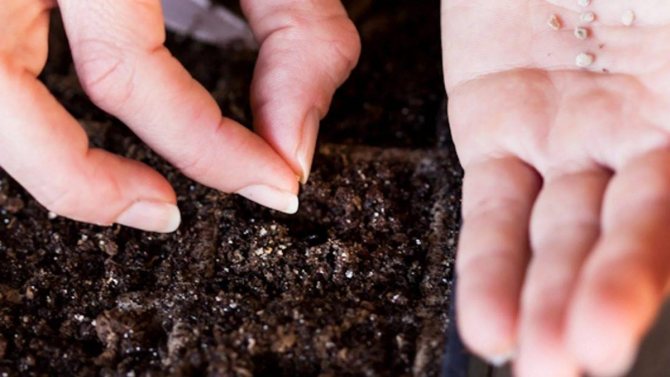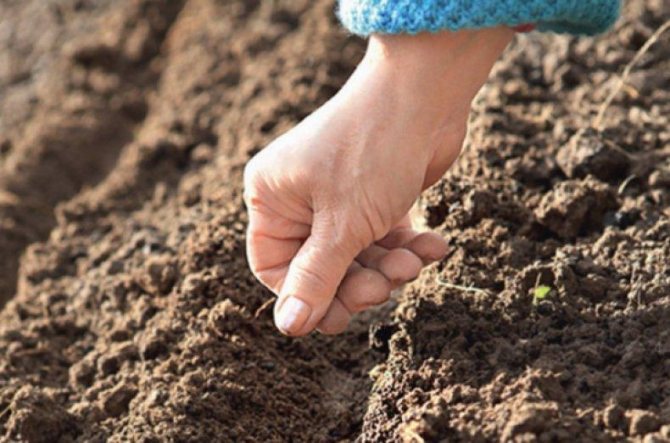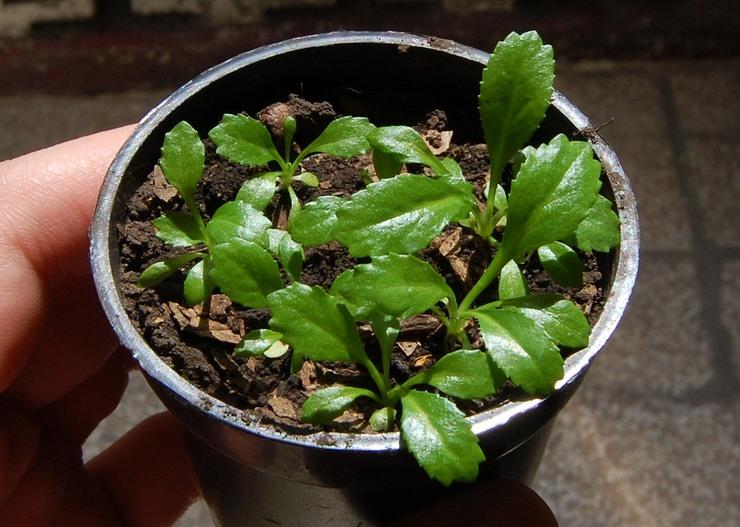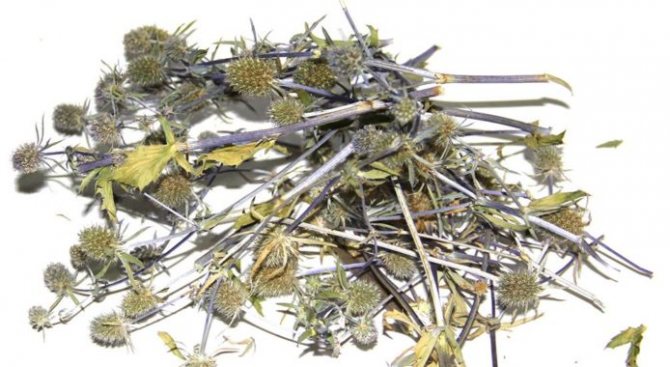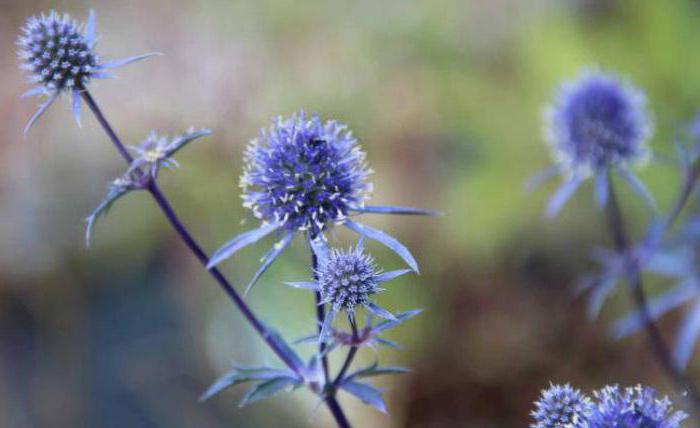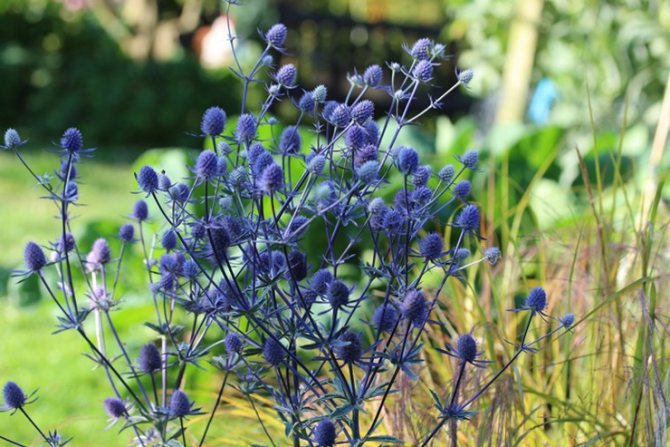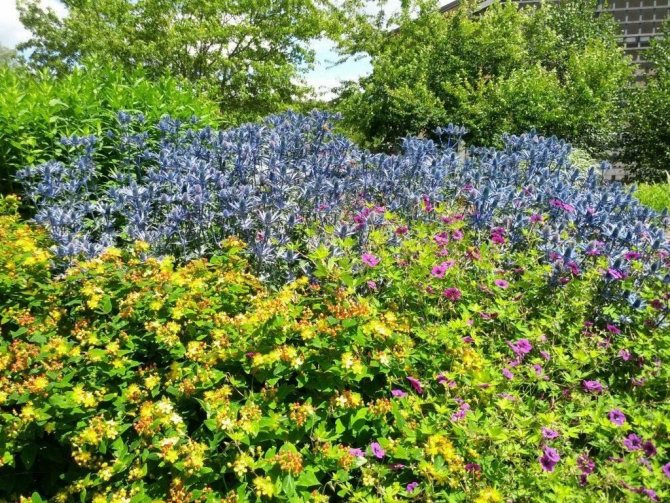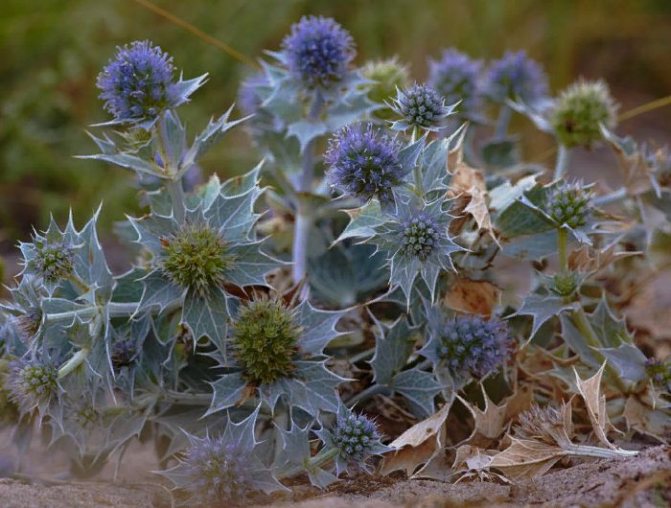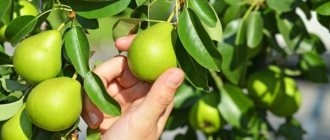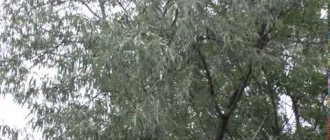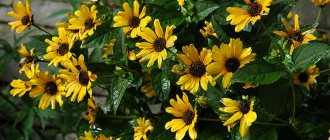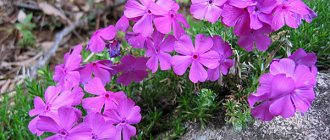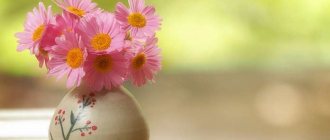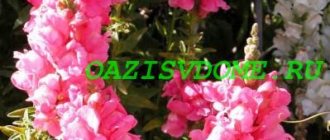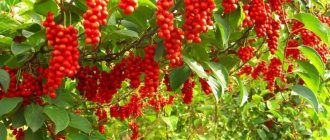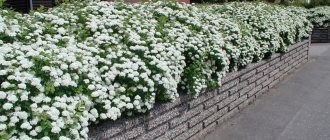Field erythematosus - a folk remedy for dry bronchitis, as a means to regulate the menstrual cycle and treat stomach diseases. A medicinal plant used in traditional medicine.
Latin name:
Eryngium campestre.
English name:
Field eryngo.
Family:
Umbellate - Apiaceae.
Popular names:
mykolaichiki polovі, barren thistle.
Pharmacy name:
erythematosus root Eryngii radix.
Parts used:
rhizome.
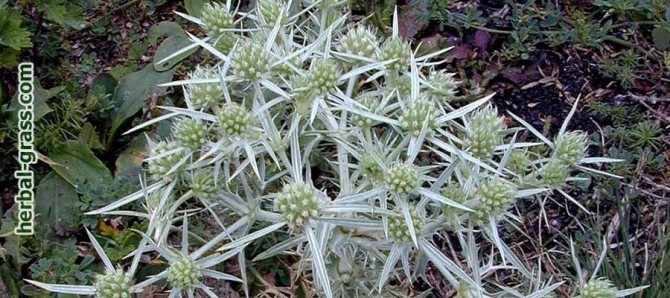
Photo of a medicinal plant Einegolovnik field
Botanical Description:
field erythematosus is a perennial herb with a very branched, thick stem and short petiolate or sessile, hard and thorny leaves. The multi-flowered capitate inflorescences are surrounded by a sheath of cover leaves with protruding spines at the ends. The covering leaves of individual whitish or grayish-green flowers are narrowed into subulate spines. The brown, lignified rhizome is thick, rounded. The erythematosus blooms from July to September.
Habitat:
the homeland of the erythematosus is most likely the Baltic countries, southern Siberia and North Africa. Quite often found in Central Europe on poor meadows, wastelands, sandy slopes and slopes, on roadsides.
Collection and procurement:
medicinal raw materials - rhizomes - are dug up in spring and autumn. Dry in the air, after dividing it in half.
Chemical composition:
saponins, essential oil, a little tannin, traces of alkaloids, malic, citric, malonic, oxalic and glycolic acids.
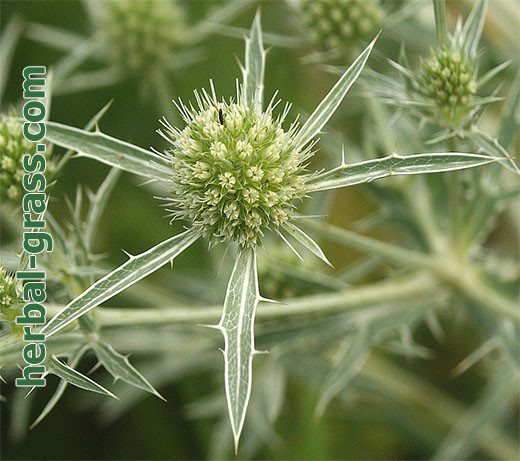

Photo of a medicinal plant Einegolovnik field
Types and varieties
The mountains of France, Eastern Europe and Western Yugoslavia are considered homeland, it is also found in Russia.
Alpine erythematosus is a perennial plant 70 cm in height with bare, erect, branched stems at the top.
Basal foliage is cordate, on long petioles. The flowers of the alpine bluehead are blue, each flower is located in the axils of each bracts.
And the inflorescence is capitate, dense, cylindrical in shape.
Alpine bluehead varieties are distinguished by shades and luxury of "collars". The erythematosus varieties "Amethyst
"They are lilac;
"Blue Star"
- blue, in the variety
"Blue Jackpot"
also blue, but quite large.
In its natural environment, it grows in southern and central Europe.
Perennial plant with thorny, leathery leaves. The flowers of amethyst erythyst are blue or blue, collected in a spherical or ovoid capitate inflorescence. Wrap during flowering blue color.
The Caucasus is considered the homeland.
Tall species, reaching a height of 1.5 m. Biennial plant with leathery foliage; the basal foliage is whole, on long petioles, and the stem foliage is sessile, prickly toothed. Inflorescences of alpine erythematosus are large, oblong-obovate.
The flowers are white. The leaves are silvery-grayish with a metallic sheen during the flowering period, which occurs in August. It reproduces well by self-seeding.
The giant erythematosus looks like a small ghost lost in the garden. Available grade Silver Host
... In it, the best features of the species are the white coloring of vegetative parts, a flat "collar", the splendor of which is enhanced by long spines, and the number of inflorescences reaches a hundred.
In nature, it grows in the Caucasus, Siberia, Northern China and Central Asia.
Perennial plant 1 m tall. In the upper part, the stems are branched, bluish. The foliage is tough, thin, leathery. The flowers are blue and blue, collected in an egg-shaped inflorescence. The leaflets of the envelope are linear, blue, subulate-toothed. It blooms for 40 days in July.
Homeland - Crimea, the Baltic States, Western Europe, Western Transcaucasia.
A perennial plant with thick bluish stems. Basal foliage petiolate, cordate or kidney-shaped, leathery, spiny-toothed.
The flowers are pale blue, collected in globular inflorescences. Leaves are wide, spiny-toothed, steel-colored.
Description
The height of the representatives of the genus depends on the species, ranges from 40 to 150 cm. The root system is pivotal. The stem is erect (sometimes semi-recumbent), bare, bluish, branched at the top. Leaves are hard, leathery, round or ovate, lanceolate, pinnately dissected, dentate, prickly along the edge. Basal leaves are long-petiolate, stem leaves are sessile. At the beginning of plant growth, the color of the leaves is green, then it becomes whitish. The leaf plates of adult plants are steel blue in color.
Feverweed
The flowers are small, collected in ovoid umbellate inflorescences. Heads up to 2 cm in length, usually blue-blue, located at the tops of branched stems. The flower is framed by a cupped wrapper with dissected leaves, prickly, in length equal to or exceeding the size of the flower, located horizontally or raised. The color of the flowers is intense blue, blue-blue, blue-purple. Fruits are scaly two-seedlings.
Growing environment - sandstones, steppes, meadows, highlands, thickets of bushes. Erythematosus can be found along roadsides, on wastelands, in dry fields, on sandy river banks. Because of its resemblance to a thistle, erythematosus is often associated with weeds.
The erythematosus blooms in July - August. Dried flowers retain their decorative effect and are used to create flower arrangements. Some types are used in official and traditional medicine. The herb has soothing, analgesic, blood-purifying, expectorant properties.
The plant is winter hardy. The leaves overwinter partially (in the root rosette), the stem dies off for the winter.
Dried erythematosus
Using erythematosus
Tall specimens look good singly or in group plantings, low ones are beautiful in mixborders, rabatkas.
Eineheads are used in the preparation of winter bouquets. Low types of erythematosus can be used in an alpine slide.
Flat-leaved erythematosus appeared in my garden 10 years ago, when I experimented with planting different dried flowers. In addition to eringium (this is the scientific name of the erythematosus), I then grew a tease and many different spikelets, but all of them did not take root in my dacha - someone froze, someone did not like the soil, and blue thorns and bluish feathery leaves of the erythematosus delight me everyone season. Here are the main secrets of agricultural technology of this unpretentious plant, which I have accumulated over several years.
How to use erythematosus for magical purposes?
This plant is used to make protective pouches. Fresh grass is collected, placed under a pillow for seven nights, and then squeezed out of juice. A clean cloth is moistened with this juice, then soaked in wax from a church candle and fumigated with incense. Such a talisman has protective properties that protect against evil spirits, including for travelers.
A special sphere - the marriage bond - was also strengthened with the help of this plant.Spouses need to eat two halves of one inflorescence of flat-leaved erythematosus to reconcile and harmonize relations.
This component has been used since time immemorial in the magical rituals of Water and Sea, in rituals to establish peaceful relations.
You can use this plant and those who are not versed in magic, but believe in the miraculous power of nature. A bouquet of erythematosus, placed in the house for several days, will cleanse the home of negativity and evil.
How to grow erythematosus from seeds
Erythroat seeds can be sown in open ground before winter, because in nature, it spreads by self-seeding. I had only one packet at my disposal, so I did not risk it and planted the precious seeds in a container for seedlings. I had to wait at least three weeks for seedlings, I remember that I was already going to throw out the soil, and then almost all the seeds sprouted. I transplanted seedlings into the ground already at the end of May, by that time the sprouts were well stretched out, because they were cramped in the container; besides, the temperature on the windowsill was much higher +18 - 20 degrees. For myself, I concluded that it is better to move dried flowers of this type into the ground in a compact form, otherwise they are easy to break. However, my “pets” survived the transplant surprisingly easily. Soon the leaves grew stronger, small rosettes appeared. In the first year I loosened them, freed them from weeds, covered them with spruce branches for the winter. Einehead winter well and in the second year gave flower stalks with amazing cones of heavenly color.
Bouquets with Einegolovnik Einegolovnik in floristry


After cutting, the inflorescences retain their integrity and decorative effect for many years. Gray "hedgehogs" are appropriate both in wedding bouquets and in Christmas compositions.
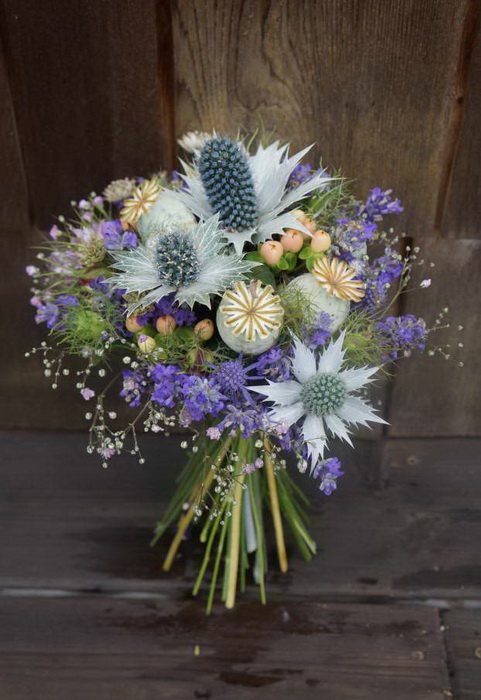

In combination with tulips, lilies, eringium plays on the contrast of textures and colors. It sets off well the flowers of the white and pink palette.
How to divide the erythematosus bush
As time went on, the bush wintered well, was renewed every year, but remained compact enough, and no self-seeding was observed in the garden. From this I concluded that this is, apparently, a hybrid, and if I want to share with the neighbors, who also wanted to decorate the lawn with blue cones, then I would have to divide the bush. The first time I performed this procedure with caution, because it is believed that dividing the erythematosus in this way is not the best idea, because it has a very fragile rhizome. However, everything went well. In the spring, I cut off a small piece of plant with a large piece of land with a shovel, then I repeated this procedure again the next spring - now two of my neighbors have lush erythematous bushes. The mother plant also underwent the operation calmly.
Plant for sciatica and migraine
Erythematosus flat-leaved is also used for radiculitis, migraine, osteochondrosis and toothache. An extract can be prepared from this plant. To do this, you need to pour 4 large spoons of leaves, stems and flowers of the erythematosus with a liter of water. The container with the drug must be placed on fire and brought to a boil. After that, you need to evaporate ½ of the original volume. Strain the finished product into a dark glass container. The extract can be consumed three times a day for 20-25 drops. The shelf life of such a product is 1.5 years. You can store the extract in the refrigerator.


What place to take eringium in the garden
Einehead retains decorativeness throughout the season, in June it has small green cones, in July they become larger, and in August they turn blue.
It is believed that the erythematosus is perfect for different curbs - along the path or at the edge of the site. It also looks impressive in mixed perennial flower beds, because it is a bright blue shade (almost amethyst) creates a spectacular combination with many colors: With white (gypsophila, chamomile), With yellow (snapdragon, calendula), With red (poppies, shabo carnations).There are two points to take into account when placing the erythematosus in the mixborder: 1. The plant reaches a height of 60 - 80 cm, so it cannot be brought to the fore. 2. Following the erythematosus, you need to plant medium-sized flowers of 30-40 cm so that they do not look like an elephant and a pug. Flowers with small heads, of field origin, and not exotic species look very good, then the illusion of a flower meadow in the garden is created.
At my dacha it so happened that the erythematosus grows by itself, we originally planted it in a separate place so as not to lose, because it bloomed in the second year, and there it took root. Because gradually I stopped cultivating the area around the plant, it turned out that it grows among the green lawn. It looks very impressive, I am very glad that I did not plant anything next to it.
How to prepare infusion and decoction?
For medicinal use of any medicinal plant, it is necessary to properly prepare infusions, decoctions or tinctures based on it. Flat-leaved erythematosus is used most often in the form of dry leaves and flowers. Raw materials are harvested during flowering, and this is July-August. The collected stems with leaves and flowers are cut into pieces with a clean knife or scissors and dried without access to sunlight in a draft until brittle. You can store flat-leaved erythematosus in a dry form for two years in cardboard boxes.
To prepare the infusion, used as an expectorant, sedative, for lotions for fungal skin diseases and dermatitis, 10 grams of dry raw materials should be placed in an enamel bowl placed in a water bath and poured with a glass of boiling water. Cover the bowl and simmer over low heat for at least 15 minutes. Then remove the bowl with the infusion from heat and leave to cool at room temperature for 45 minutes. Squeeze the resulting infusion through several layers of mesh fabric. Inside take such a remedy 1 tablespoon before meals 3-4 times a day.
The broth is prepared from 10 grams of dry raw materials and 1 cup of boiling water, also in a water bath, but it is boiled for at least half an hour, and squeezed hot. Such a remedy helps well with various poisonings, especially mushrooms. It is also taken 1 tablespoon before meals 3 times a day.
There is one feature in the treatment with erythematosus, it concerns women. Treatment with this plant should be discontinued 2-3 days before the onset of menstruation, as it enhances this process in the female body.
Eringium in dry bouquet
In September we cut off all the flower stalks. The most beautiful twigs are sent in a dry bouquet, for this purpose they need to be dried hanging in a dark, well-ventilated place. In reality, the buds and leaves begin to dry out even on the stem.
True, the bluehead tends to crumble in the bouquet, so it is better to treat the bumps with a special varnish or update the composition every year. If you are superstitious, you can tie a small bundle and hang it over your front door. the people call this plant "chertogon" and believe that it drives away evil spirits. I also harvest some erythematosus as a medicinal plant - I read that it works as an expectorant, helps with toothache, I have not tried it myself, but I keep it just in case.
Eryngium
Is a perennial herb from the Umbrella family. Biennial and annual varieties are also found. Grows in southern and temperate latitudes.
The maximum height of the erythematosus
- 1.5 meters. The root system is pivotal. The stem of the plant is erect, has a blue tint. The leaves are round or ovoid. The edges of the leaves are prickly. In a young plant, the leaves are green. They become whiter as they get older. In adult plants, the leaves are blue with a steel tint.
The flowers of the bluehead are small in size. They are collected in inflorescences that are shaped like umbrellas.Usually the inflorescences are blue, blue or purple. They are located right at the tops of the plant's stems. Cut thorny leaves are located around the flower. The leaves are raised as well as horizontal. Sometimes they exceed the height of the flower or are equal to it.
Erythematosus can be found in meadows, in steppes, on roadsides, in sandy areas. Visually similar to a thistle, so the erythematosus is often mistaken for weeds. Flowering begins in July and ends in August. Dried flowers retain their decorative qualities, therefore they are often used to create a variety of flower arrangements. Erythematosus is a winter-resistant crop.
In the title photo there is a foreign alpine bluehead variety "Blue Jackpot".
The healing properties of the plant
One of the medicinal plants actively used in folk medicine is flat-leaved erythematosus. The medicinal properties, features of drugs based on it are such that the scope of their application is very multifaceted. This plant has a diuretic, anti-inflammatory, antifungal, expectorant, antispasmodic and sedative effect. Medicines based on erythematosus are used to treat the following diseases:
- headaches;
- fungal skin lesions;
- dermatoses;
- gastrointestinal colic;
- upper respiratory tract diseases;
- liver disease;
- whooping cough;
- urolithiasis disease;
- weakening of cardiac activity;
- swelling;
- rheumatism;
- epilepsy.
The use of flat-leaved erythematosus makes the treatment of higher quality, especially if it is carried out with a complex of means.
What types are there?
Some varieties of this crop are grown as ornamental plants.
Alpine Eryngium alpinum
native to the mountainous regions of Eastern Europe. It grows up to 70 cm. The erect stem has thorny leaves. The plant is completely bright blue. Around the inflorescence, collected from small flowers, there is a wrapper of leaves with prickly, jagged edges. Flowering occurs in July.
Amethyst
a plant species native to the South and Central Europe. The bush is about 70 cm high. The leaves have thorny edges. Rounded or heart-shaped small flowers are blue or blue in color. The leaves around the inflorescence have a lilac color with a blue tint.
Amethyst
Bourget
- a variety native to the Iberian Peninsula. Practically not used by gardeners. This is a stunted species. Plant height does not exceed 40 cm. The thorny leaves are green with a blue tint and white veins.
Giant (E. Giganteum)
Is a tall species of the genus. Grows up to 1.5 meters. Refers to biennial plants. Gray leaves with a blue tint have spiny jagged edges. The flowers are large enough - blue with a steel shade. A large number of them are inflorescences, around which there are thorny, silvery leaves. The giant erythematosus blooms in July and stops blooming in August.
Flat-leaved species (E. planum)
Is a perennial that is often used for medicinal purposes. It can grow up to 1 meter. The stems have a blue tint. The leaves are round and tough. Flower color: pale blue, blue or blue. In the wrapper, the leaves are jagged, blue with greenish tints.
Seaside erythematosus (E. Maritimum)
grows in the wild in the Baltic countries, on the Crimean peninsula. The stem grows up to 70 cm and has a silvery color with a blue tint. The leaves are round or heart-shaped. Their edges are represented by spiny teeth. Bluish flowers make up the inflorescences, which are in the shape of a ball. There are thorny leaves around the inflorescence.
Field erythematosus (E. Campestre)
also called plain. Wastelands and steppes are the main environment for the growth of culture. The color does not differ blue.The stem grows up to 60 cm and has strongly dissected blue-colored leaves.
Unusual flower
A wild plant, common in the southern territories of the forest zone and in the steppe zone of our country, bears a name that corresponds to its appearance - flat-leaved erythematosus. It refers, oddly enough, to umbrella plants, although outwardly it does not in any way resemble the same dill. This inhabitant of meadows, forest edges, river banks, steppes differs in its color. From the very root to the crown, it is covered with a blue-violet haze, and the higher, the more such an unusual color appears more and more brightly, reaching all its beauty on the ovoid flowers of the plant.
Biology studies plants in order, families and genera, this also applies to such an interesting plant as flat-leaved erythematosus. The flower formula in the taxonomy of higher plants is based on the formula of the main representative of the order Araliales, Apiales - Araliales, Celery, Apiaceae families, Umbelliferae - Celery, Umbrella - Hemlock speckled. Its type is as follows - Ca 5 Co 5 A 5 G. This is a very narrow area of plant science, not needed by a common man in the street.
Most popular varieties
Blue Star
Is a very popular variety. Due to its beautiful blue shining color it is highly prized by florists. The wrapper is represented by numerous sharp, long, blue-silver leaves. It grows up to 90 cm. Flowering occurs in the second half of summer. This is a varietal variety of an alpine plant species. The flowers are bright blue. Ideal for winter bouquets.
Braggart
- This is a variety of flat-leaved erythematosus. Perennial, very ornamental plant. The maximum height is 70 cm. Small bluish or blue flowers are folded into inflorescences, surrounded by numerous thorny leaves. The variety is unpretentious, loves the sun. It is used in single or group plantings. Also
Fanfaron is an excellent choice for creating winter bouquets.


Braggart
Blue Star
- an unusual ornamental plant. It is a variety of the alpine erythematosus. Inflorescences have the shape of an elongated head. The leaves are large, silvery. The flowers have a deep blue color. The variety blooms in the second half of summer. Plant height does not exceed 90 cm. The variety is cold-resistant.
Alpine sky
- a variety common among florists. The plant turns blue as it matures. The inflorescences are framed by tough, thorny leaves. The color is perfectly preserved during drying. It is usually used to create dried compositions. The best soil for the variety is alkaline.
Some recipes for traditional medicine
For the preparation of medicines, the roots, flowers, stems and leaves of the plant are usually used. To cure tuberculosis, it is necessary to take the juice of the erythematosus flat-leaved in a tablespoon, preferably three times a day. Before use, this remedy should be diluted in half a glass of water. You can add a little honey to the drink.
A mouthwash can be used to treat toothache and inflammation in the mouth. To prepare it, you need to pour a glass of high-quality vodka with a tablespoon of the stems and leaves of the bluehead. Use the drug only after brushing your teeth.
Reproduction
The plant reproduces by dividing the bush as well as the seeds. The second method is much better, since the roots are very brittle, and the cut seedlings take root very poorly. The division is usually carried out in late spring. When planting, it is necessary to leave about 40 cm between the plants.
But it is still better to propagate the erythematosus by seeds. You can sow seeds directly into open ground, or through seedlings. If you sow seeds in open ground, then this should be done at the end of autumn.
For seedlings, sowing seeds is carried out in February or March.If the air temperature is about 20 degrees, then the first shoots appear after 3 weeks.
Place and soil
Einehead is so unpretentious that poor soil, dust at the side of the road is not afraid of it. However, a sunny, open area with light, drained soil, not acidic, will undoubtedly be more to his liking. Easily tolerates minor shade from tree crowns.
Landing
Erythematosus is grown through seedlings or sown directly into open ground before winter. Sowing for seedlings begins in February. At a temperature of 18-20 ° C, after 3-4 weeks sprouts will appear, which need to be dived into separate pots.
In a permanent place, erythematosus seedlings are planted every 35-40 cm, adding a handful of lime under each plant to improve the color of the inflorescences. If necessary, drive a peg next to the plant for future tying.
It is noticed that the varietal erythematosus forms more inflorescences than the natural one, therefore, there is a high probability of the rosettes falling off from their own weight, this is especially important for tall species.
Flowering begins in the second year of life, in July-August. After flowering, the rosettes are not cut off, since they are interesting even when withered. And if you need to clear the area after flowering, then cut off the entire ground part (at the root).
Planting and leaving
Any soil is suitable for growing. However, the moisture-rich soil will be more to the liking of the Sinegolonics. A handful or two of lime must be added to the pits. As lime, you can take ground eggshells. Lime will enhance the color.
Caring for the plant is not too complicated. Around the bushes, the soil needs to be loosened regularly. Long stems in early summer should be tied to some kind of support.
This crop has good resistance to cold and frost.
Description of the erythematosus
Eringium, or feverweed (Eryngium) is a magnificent herbaceous perennial, often attributed to cultural thistles, but still deserving of much more respect. Reaching a height of 30 to 100 cm, Eringium conquers with its weightless lace look.
Erythroat shoots branch densely at the top, whole rounded-heart-shaped bottom and pinnately dissected leaves on the shoots form a lush bush that looks like a luxurious decoration of any composition and genuine lace, and the play of metallic and blue hues adds luxury to the plant. But erythematosus is valued primarily for the capitate inflorescences, surrounded by hard-prickly leaves of the wrapper, in which blue or blue small flowers sit in the axils of the lanceolate bracts.
In nature, the number of blueheads is not limited to two hundred species, but only about a dozen species are used in garden culture - and magnificent hybrid blueheads, as well as giant, amethyst, Bourget, alpine, seaside, flat-leaved. Regardless of the variety and species, all erythematosus reproduce in the same way (just the same).
Application and useful properties
Enegolovnik is used not only in landscape design and in floristry. It is grown for cutting. Dried and used in a variety of dried flower arrangements. But that's not all.
The plant is also used for medicinal purposes. This is especially true of the flat-leaved erythematosus. An infusion and decoction of this herb is used as a sedative.
The culture is believed to cure bronchitis, whooping cough, cough, insomnia, and even kidney stones. Also, the use of erythematosus decoctions can cause menstruation, relieve pain. Used as an anti-inflammatory agent.
However, it must be remembered that before using any traditional medicine, consultation with a specialist is required.
It is also believed that the plant has magical properties.And today, dried bunches of erythematosus are often hung over the entrance to the house so that a person who is capable of committing evil does not enter it.
What is useful in erythematosus?
Traditional medicine has used plants for the treatment of various diseases from the most distant times. Herbalists did not bypass the side and flat-leaved erythematosus. Studies have shown that all parts of the plant contain:
- vitamin C;
- glucose;
- fatty oil;
- coumarins;
- organic acids;
- saponins;
- sucrose;
- tannins;
- triterpenoids;
- phenol carboxylic acids;
- flavonoids;
- fructose;
- essential oils.
At present, all the properties of this plant are still not well understood.
Einehead in landscape design
Despite the fact that the plant is not particularly beautiful and colorful, it is very often used by landscape designers and florists in their creations. The culture feels great in group and single plantings, it is appropriate in But most often it is used to create winter bouquets and other floral arrangements. Usually, the erythematosus is used as a dried flower. It retains its color perfectly during drying. Cutting the flowers is necessary when the inflorescences are completely blooming.
Looking through old photographs, I remembered that winter bouquets were very popular in the 70s. This is a bouquet on the table of my first teacher, this is on the piano at a music school, and this one is at our house, near the mirror ... In each apartment there was a vase specially designed for dried flowers. Most often, dried meadow flowers, autumn leaves and panicles of natural cereals were placed in it. And there were few "real", garden dried flowers. In stores, their seeds were extremely rare. I had to look for them from friends.
Gradually, interest in dried flowers faded, but now it is growing again. Convenient composition tools are now on sale. A special floristic sponge (oasis, piaflor) allows you to fix the plant stems in different directions. The vases themselves are also presented in a wide variety: low and high, wooden and ceramic, wicker, - in short, for every taste. And most importantly, the list of plants has expanded. Dried flower seeds are sold separately or in kits, with sowing recommendations. Which plants to choose? Let's get to know them better.
The botanical name of the plant, which is popularly called thistle, is eryngium
... The genus includes about 250 species, distributed in tropical, subtropical and temperate latitudes of the globe. These are perennial, rarely biennial and annual herbaceous plants; height - from 40 to 150 cm. Leaves are leathery, whole or dissected, spiny-toothed along the edge. Basal and lower stem leaves on petioles, upper ones sessile. The flowers are small, blue or blue, collected in capitate inflorescences. Usually, the inflorescence is surrounded by large, stiff leaves of the envelope, often prickly. For the thorns, the erythematosus is called the thistle (although the real thistle is a completely different plant).
Most species of erythematosus in Central Russia are quite winter-hardy, with the exception of s. variegated, with. agave and c. proteiflorum, which grow only in the south of Russia and even hibernate there with shelter.
More often than others, flat-leaved erythematosus is grown in gardens, p. alpine and c. giant. All of them are very hardy: they can grow on sparse rocky soil, in dust along the roadsides.
Erythematosus flat-leaved
(E. planum) - perennial. It can be seen in meadows, on road embankments and even in wastelands in the city. It has blue or blue flowers, collected in small but numerous round heads. The stems and leaves are also purple or blue. The height of the species is from 30 to 60 cm. In general, the flat-leaved erythematosus is a rather graceful plant, suitable for alpine slides. But there is one condition: the soil must be poor, on fertile lands the size of the bush increases.Flat-leaved erythematosus is exceptionally frost-hardy: in Siberia, without special shelter, it endures frosts of forty degrees.
Alpine erythematosus
(E. alpinum) is a higher perennial, up to 80 cm. The capitate inflorescences are round or elongated. They are larger than those of flat-leaved erythematosus, but there are less of them on the plant. The inflorescence is surrounded by a beautiful bluish wrap. The heavily dissected leaves of this wrapper resemble the exquisite lace collar worn by women of high society in the Middle Ages. The plant is extremely expressive. It looks especially beautiful among stones, the gray background of which emphasizes the blue hue of flowers and leaves. It harmonizes with cereals and other dull plants.
Giant erythematosus
(Еryngium giganteum Bieb). Homeland - Caucasus. The tallest species, reaching 150 cm in height (noticeably less on stony soil). Biennial herb with leathery leaves; basal - whole, on long petioles, stem - sessile, deeply cut, prickly-toothed. The capitate inflorescences are oblong, large, up to 6 cm long. The flowers are whitish. The leaves are silvery-gray to blue-green with a metallic sheen.
The ghost of the English garden
In England, the gigantic erythematosus is known as the "Ghost of Miss Wilmott". It is no coincidence that such an unusual name was given to the plant. At the time of Queen Victoria, a certain Miss Wilmott, as a true lady of that time, was fond of gardening and was so fascinated by this plant that she planted its seeds in the gardens of her friends. She wanted him to grow everywhere! The plant appeared as if from nowhere, because the gardener did not plant it. And at dusk it really looked like a ghost. The silvery leaves reflected the moonlight, causing the erythematosus to emerge from the darkness.
In memory of this story, one of the varieties is named Silver ghost
(Silver Host), which means Silver Spirit. This variety has absorbed all the best that this species is famous for: a very large "collar", up to 12 cm in diameter, a pronounced silvery shade, and the number of inflorescences on the stem reaches hundreds. But, there is one drawback: this species is a monocarpic, that is, after flowering, it dies off.
What do they love
Erythematosus prefer open, sunny places with well-drained soils. There is almost no care for them. They belong to those plants that only become more beautiful in Spartan conditions. When planting, it is advisable to add 1-2 handfuls of lime under each plant, which will contribute to a more intense coloration of the inflorescences.
Erythematosus are propagated mainly by seeds. Plants are often self-seeding. Seeds are sown before winter in open ground or for seedlings in March. Shoots appear on the 20-30th day. Seedlings dive into separate cups, as the plants get sick from the transplant.
Seedlings are planted in a permanent place after 35-40 cm. In the first year of life, a rosette of 5-7 leaves grows. From the second year, a flower stem is formed. Plants bloom in July for 2-3 weeks. "Cones" last for a very long time and continue to decorate the garden.
Erythematosus is rarely propagated by division. Its fragile roots are damaged during excavation. Plants are transplanted only at a young age.
Erythematosus are quite changeable. In nature, you can find plants of very bright and very pale shades. On the basis of this, varieties with a deep blue and silver-gray color were bred. Choosing a background for them, you can create very expressive compositions. Unlike natural plants, varietal plants form more inflorescences. Thin stems of flat-leaved erythematosus even need to be tied up so that this whole bouquet does not fall under its own weight. Tall species of erythematosus are planted in the background. Plants are placed in the environment that are in harmony with these impressive thorns, but do not overshadow them.
Eineheads are classic components for winter bouquets.If you cut plants in full bloom, they will retain their appearance for many years. For drying, the plants are hung upside down. In the old days, in every house there was a bunch of blueheads. It was placed on the porch or hung over the threshold of the house. It was believed that not a single creature with malicious intent would be able to cross the threshold of a house if there was an erythematosus on the way.
M.B. Sharova, biologist
This article can be found in the magazine "Magic Garden" 2011 № 2.
The embossed capitate inflorescences that form in the summer of these stately plants attract attention and give height to the mixborder. Their inflorescences resemble thistle inflorescences, attract butterflies and bees, and are surrounded by even more spectacular prickly bracts, which, like the upper part of the stems, are usually brightly colored. Most of the species and varieties of blueheads described below are perennial herbaceous plants, half of them are evergreen, and only two are completely winter hardy. They bloom from mid to late summer, their dry buds are especially effective in winter arrangements.
E. agavifolium (C. agavolistny)
Evergreen thermophilic plant, forming a dense bush, with greenish-white capitate inflorescences up to 5 cm in diameter. Leaves are dark green, hard, xiphoid, with sharp serrated or serrated edges, mostly collected in basal rosettes. The height and diameter of the plant is 1.5x0.75 m.
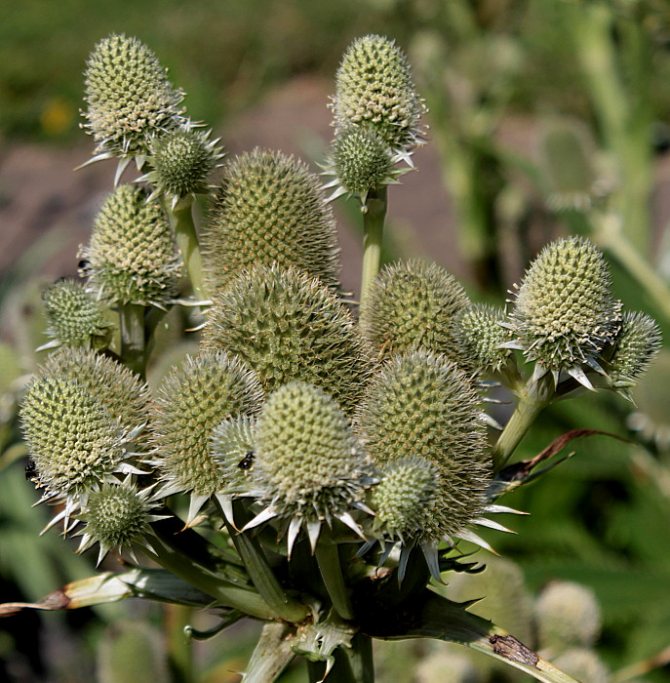

E. alpinum (S. alpine)
One of the most reliable species for central Russia, forming blue-violet inflorescences resembling a tease, up to 5 cm long, surrounded by feathery bracts of the same color. A winter-hardy perennial herb that forms a dense bush with shiny dark green heart-shaped basal leaves with jagged edges. The height and diameter of the plant is 1x0.7 m.
Beauty from nature
Flat-leaved erythematosus is an amazing plant with very spectacular flowers with an unusual color. It is not grown in culture, it is still only a wild plant. But its beauty, useful properties are used by man. This flower has already been well studied in biology. Its scientific name is Eryngium planum. It is practically not used in animal husbandry, since it does not grow in cultivated fields, and its stems are quite tough. But as noted by scientists, deer love to eat erythematosus.
Man uses this flower for medicinal and magical purposes. But even for a common man in the street, he is of interest for his appearance. Unusual flowers will decorate the room with a delicate lilac-blue tint, and if you also take into account the magical protective properties of the erythematosus, then such a bouquet should be collected during the time the plant blooms.
In the conditions of the south and middle zone of Russia, the erythematosus (eringium), of which there are more than 250 species, is increasingly found in the landscape design of the personal plot. The most common species are flat-leaved, giant and alpine due to resistance to frost and unpretentious care. Well alpine slides and rocky structures are combined with white and yellow flowers, cereals, mordovnik.
It is believed that the erythematosus has some magical properties, for example, by hanging it over the threshold of the house, no one who is evil-minded will cross it. Therefore, the erythematosus was stocked up for future use, drying the bouquets with "cones" down. Dried for 10 days. Also, in dry form, the erythematosus is often decorated with flower arrangements.
Photo gallery of views
Folk omens
Erythematosus is a versatile plant, in addition to decorative and medical qualities, it also has mystical ones.
In Russia, this plant is often called thistle or thistle. The dried grass of the erythematosus was hung over the threshold of the house in order to ward off not only evil spirits, but also unkind people.
However, from a botanist's point of view, thistle is a different plant.
Another interesting property and sign of the erythematosus is an increase in sexual desire.In the old days, women collected the roots of the erythematosus, candied them and treated them to their husbands.
The use of erythematosus in traditional medicine
Since the root of the culture is rich in tannins, acids, essential oils, traditional medicine could not ignore the beneficial properties of the plant. Decoctions and infusions prepared from roots and herbs give a good expectorant effect, are used as a diuretic, stimulate the intestines, improve liver and stomach functions. However, a group of diseases prohibits their intake. They should not be used by hypertensive patients, pregnant women, patients with diabetes.
The roots of the plant are harvested in the autumn or early spring. They are freed from the ground, cut into pieces and dried in well-ventilated storerooms or under a canopy. Ready-made roots can be stored for up to three years.
The grass is harvested during flowering. It is crushed and air-dried, always in the shade. The prepared herb can be used for 2 years.
Growing plants
Erythematosus do not like waterlogged soil and constant dampness, but in general, even very young plants are hardy and there are no difficulties with growing them. Watering is carried out neatly. Gradual accustoming to non-greenhouse conditions is not necessary, the film or glass is removed immediately after the emergence of friendly shoots. Feeding for erythematosus seedlings is not applied.
But the temperatures need to be paid more attention. It is better to keep the erythematosus in moderate room temperatures from 18 to 20 degrees. The plant does not like heat at this stage.
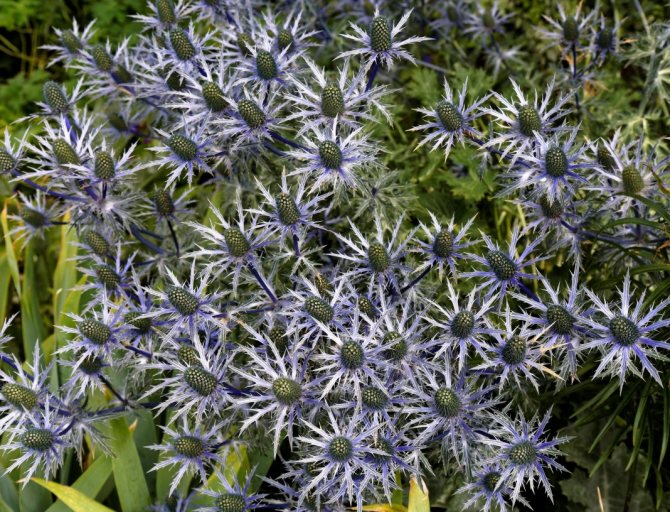

Eryngium maritimum. <>


Eryngium alpinum


Giant Eryngium (Eryngium giganteum)
Agrotechnical requirements
Unlike most ornamental plants, the erythematosus does not need watering at all. It is able to withstand even prolonged drought combined with high air temperatures without sacrificing decorativeness.
Eringium does not need additional fertilizing, on the contrary, an excess of nutrients in the soil can reduce the frost resistance of plants.
Erythematosus needs periodic loosening and weeding. It does not tolerate the proximity of weeds and the formation of a thick airtight film on the surface of the soil. In order to minimize maintenance, it is recommended to cover the soil surface with peat or sawdust.
High grades need a timely tie to the support. Reaching a height of more than 1 m, they lie under the weight of their own inflorescences.
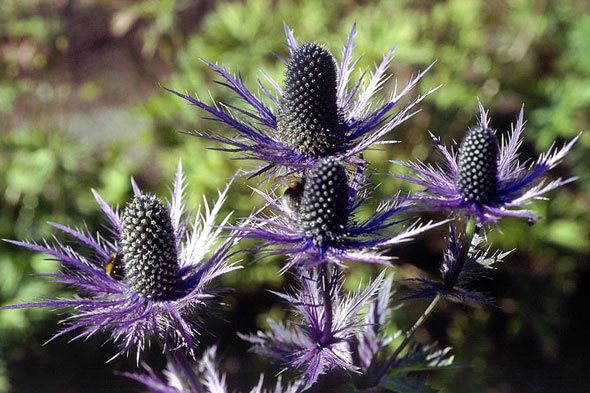

Before sending the plants for the winter, they are cut to a stump. This is a mandatory rejuvenation procedure that will ensure more lush bloom next year.
Only the most thermophilic species and plants of the first year of life require winter shelter in the form of spruce branches or fallen leaves. With age, eringium adapts to low temperatures and hibernates without problems in the conditions of the Moscow region.
Seeds - collection, how to choose
Bluehead seeds ripen well even in temperate climates and the culture is capable of self-sowing propagation. The two-seeded fruit ripens in late summer or early fall and is easy to pick on your own. To prevent the seeds from spilling out, you need to tie the inflorescence with gauze, after ripening, cut it off and dry it in the fresh air in the shade. Store in a cloth or paper bag, indicating the date of collection and grade. For sowing, freshly harvested material or one that has been stored for several months is best suited - it is sown in the winter.
When buying ready-made seed material, it is necessary to pay attention to the shelf life (12 months) and characteristics, so that instead of a perennial, you do not purchase a one- or two-year-old variety.
Optimal growing conditions
Bright, as in the photo, the erythematosus will be only if placed in a sunny area. A less preferred place is partial shade.The plant takes root well on the southern side of the rock gardens, where only the most resistant crops survive without watering.
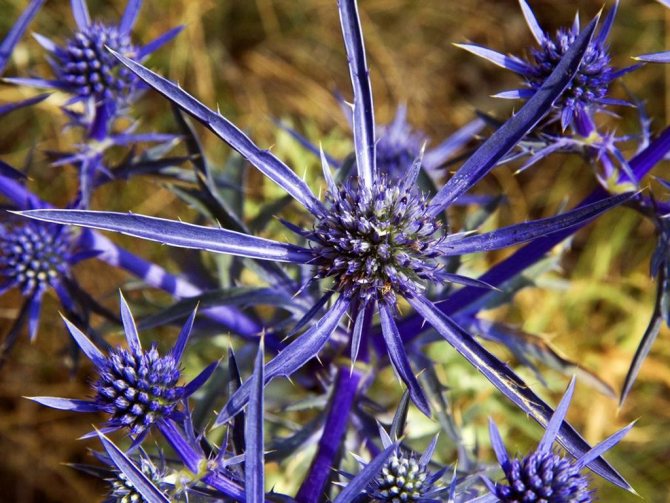

Eringium does not put forward special requirements for the soil. A soil poor in nutrients, but light and well-drained, will do. The plant will grow in sandy, garden or rocky soil. It is important that it is not soggy and too dense.
Planting seedlings, care
Erythematosus belongs to cold-resistant plants, therefore, planting in open ground is carried out in May, when it is not hot, which contributes to quick adaptation to a new place.
Seeds sown in the fall will sprout in the spring, and if transplantation from the seedling ridge is required, then this must be done before the heat. Transplanting seedlings that have sprung up in the fall is carried out in early spring.
The optimal place for culture is sunny, with little shading, the soils are light, infertile. Maintain a distance of 40 cm between seedlings, try to keep a clod of earth on the roots.
Care consists in moistening the soil in dry hot weather - you do not need to water regularly, because the plant reacts poorly to excess moisture. It is necessary to weed and loosen constantly to keep the soil loose. For high grades, install a support.
Soil and containers for sowing
Erythroat seeds are sown in boxes or large shallow containers. But you can use both cassettes and other containers divided into cells, which allow you to sow 2-3 seeds individually. This option simplifies seeding and reduces the risk of root damage when planting in the soil.
Any substrate for sowing erythematosus seeds for seedlings can be used - both universal and independently compiled light soil. The main thing is that the soil is loose and not too fertile.
When sowing erythematosus in open soil, compost and sand are added to heavy soils to change the characteristics of the soil.


Seedling of the seaside erythematosus.
Gardeners often call the erythematosus a graceful thorn.
The plant is valuable not only for its decorative properties, but also as a medicinal plant, and it is also a honey plant.
There are more than 250 species of erythematos in the world. South America is considered their homeland. Only 15 species are widespread in Russia, most of which are perennial.
Habitat
Eringium, as the plant is also called, grows equally well in the middle lane, on the southern Siberian plains, in Europe and the Caucasus. The plant thrives on sandy soils and steppes, where it can often be seen on roadsides.
North Africa, Mexico, the Baltic states - these are all habitats of the erythematosus, so well this plant is able to adapt to environmental conditions.
The chemical composition of this plant is extremely rich. It includes:
- essential oils;
- acids (malic, citric, glycolic, oxalic, ascorbic, rosemary);
- fructose;
- sucrose;
- tannins.
- phenolcarbon compounds;
- tannins;
- flavanoids;
- triterpene saponins;
- polysaccharides;
- coumarins;
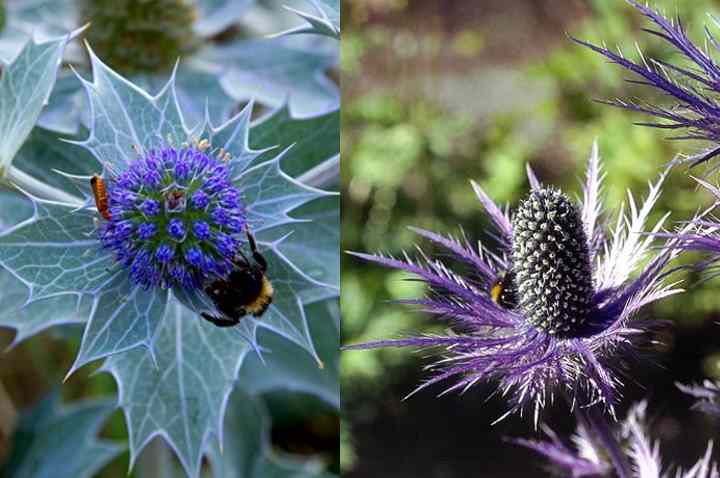

Erythematosus flat-leaved and field has a lot of useful medicinal properties, which are actively used in folk medicine:
- strengthening the stomach - the plant is added to the food;
- the infusion improves the production of gastric juice;
- the plant has anti-inflammatory, antibacterial and diuretic properties - for this they make a decoction of the root of the bluehead;
- for insomnia, an infusion of erythematosus is used, since it has a calming effect;
- the plant has an analgesic effect;
- in case of poisoning, a decoction of the bluehead will help, which removes toxins from the body.
Contraindications
The use of erythematosus has a number of contraindications:
- since erythematosus preparations can increase bleeding, they are not recommended for use during menstruation and during pregnancy;
- erythematosus in most cases increases blood pressure, so it cannot be used for hypertension.
In some countries, the erythematosus is used for cooking, since the plant has a pungent flavor.
The stems of the plant can be added to salads and marinades.
The roots are used both boiled and candied when they become a delicacy.
Cooked roots are a great substitute for a side dish in any dish.
Interesting! The roots of the erythematosus are boiled in salted water and mashed, so it turns out a wonderful side dish - mashed potatoes.
From the leaves and young shoots, a salad is prepared in a mixture with other herbs and lettuce leaves, it turns out tastier with dressing in the form of oil.
A bit of mysticism
Features of appearance, thorns on the leaves contributed to the spread of the belief that the erythematosus has a magical property - it drives away evil spirits. That is why one of the popular names for the flower is chertogon.
Bunches of stems, roots were dried and hung over the front door or planted nearby, believing that they would not let devils, various evil spirits and otherworldly entities into the house. To protect the interior, dried flowers were put in bags and placed on shelves.
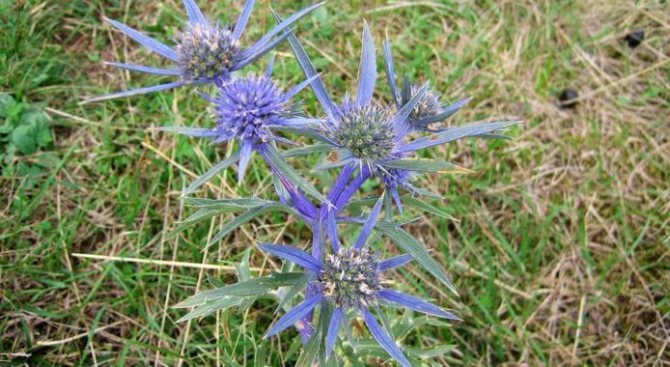

The plant is under the auspices of the planet Venus and the water elements, which endowed it with light magical power and powerful energy. Field erythematosus, its inflorescences are whitish, are used in rituals related to health, and flat-leaved erythematosus (bluish flowers) are used as a talisman and in love magic. In rituals associated with black magic, it is not used.
The simplest rituals:
- cleansing the space from negative energy, protection from the evil eye - the bouquet collected on the waning moon is hung out in a conspicuous place;
- protection from otherworldly aggressive entities, demons - several stems of erythematosus and thistles are placed under the threshold or placed above the doors, but not in the corner - there it has the opposite effect;
- to remove negative energy from the apartment, set fire to a branch and fumigate the space;
- half a flower, swallowed by each member of a married or loving couple, helps to harmonize the relationship.
Flower legend
In England, there is a legend about how and why this plant spread. During the reign of Queen Victoria, a rich lady, who was a passionate admirer of everything unusual, wanted her favorite flower to grow everywhere, and quietly planted its seeds in the gardens of the area.
The appearance of a strange plant with thorny leaves of a non-standard color caused a commotion among the inhabitants, especially since on moonlit nights the smooth leaves shone with a ghostly silvery light. It has even been compared to a ghost from the plant kingdom. Among the population, the strange plant was called "The Ghost of Miss Wilmott."


The legend has found its continuation in modern times - one of the varieties was named Silver Ghost by the breeders. The flowers of this variety are large (up to 12 cm in diameter), there are about 100 of them on the bush. The dying off of the plant after flowering further confirms the legend of its ghostly appearance.
Growing options
You can grow a bluehead by planting seeds in open ground or for seedlings. The seeds do not have very good germination, but sowing with a margin makes it possible to grow the required number of seedlings. The culture is undemanding to the soil, the main thing is that it is loose, so a not very fertile site is better suited than fertilized land. In heavy soils, you can add sand, peat, compost.
Sowing in open ground
Sowing in an open area is necessary with the onset of the first frost, when the soil is slightly frozen on top. I dug up the ridge in advance, level the surface. Place the seeds in shallow furrows, trying to distribute them evenly, at a distance from each other.With thickened plantings, it will be difficult to plant seedlings in the spring - the roots are injured, and rooting will take a long time. Shelter for the winter is not required.


If the seeds are sown immediately after harvesting, then young plants that have grown by the onset of cold weather must be covered with any covering material, and spruce branches should be spread on top.
Sowing seedlings
The best time for sowing seedlings is February-March. Seeds, evenly distributed over a wet surface, are lightly sprinkled with sand or sifted soil, covered with a transparent film and placed in a warm, cool (about 18 ° C) bright place.
It is convenient to lay out 2-3 seeds at a distance of 4-5 cm between the nests. With further cultivation, they can be transplanted in groups.
Germination will take place within 3-4 weeks. Before sprouts appear, the film must be removed regularly to remove condensation. Moisten the soil without drying out. Remove the shelter after friendly shoots appear. There is no need to apply fertilizers.
At the stage of seedling growth, care consists in maintaining the temperature in the range of 18-20 ° C - in a hot room they grow worse. Even under optimal conditions for seedlings, it is characterized by slow growth and by the time of transplanting into the ground, the seedlings are low, the roots are weak. Because of this feature, the picking can not be carried out, but immediately land them in a permanent place. Rare plantings allow you to transplant with less damage to the root system.
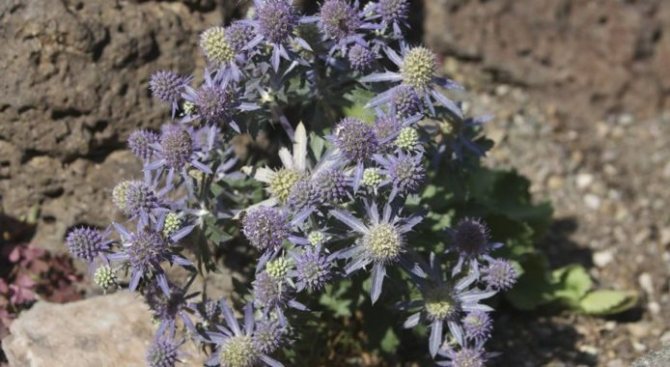

If the seeds are sown thickly and a pick is necessary, then it should be carried out without waiting for the appearance of two leaves, trying to leave more soil on the roots. Start hardening when the air warms up a little - the culture is not afraid of cold.
Distinctive features
Plants from the Umbelliferae family can be found on all continents - there are more than 3,500 species. Eryngium or Eryngium belongs to this large family; about 250 species grow on the Eurasian continent. It grows in the steppes, in shrub thickets, in dry meadows and hills, near roads.
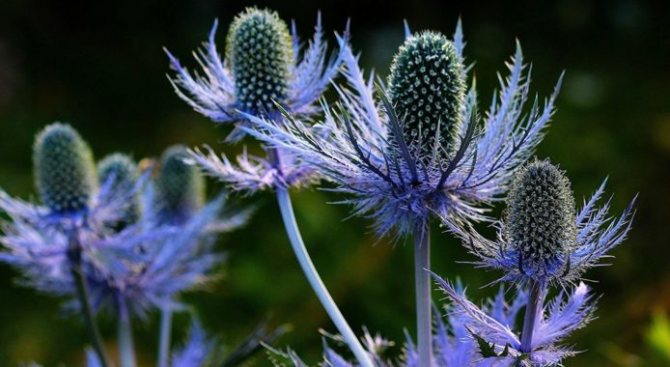

It is easy to recognize by its characteristic bluish stem branching from above and dissected prickly hard leaves of bluish-blue or gray-green color. The aerial part turns completely blue when the plant is in a favorable environment for it. The height of a lush, spreading bush reaches 35-150 cm. The fleshy taproot is able to accumulate moisture, which allows it to do without water for a long time.
An unusual shape of inflorescences gives the plant decorativeness - they resemble a dense round head framed by a blanket (wrapper) of hard thorny leaves. The inflorescence consists of small blue-blue flowers, which become deep blue on soils with a high lime content.
The species got its name because of the blue color of the inflorescence-head, and because of the thorny hard leaves, the flower is popularly called blue (blue) thistle.
Diving seedlings and caring for young blueheads
Diving for this culture is undesirable. Plants develop rather slowly at the beginning and usually, by the time of transplantation into the soil, they are still quite small, with rare sowing, they can be easily separated without injuring the "neighbors".
The optimal time for the erythematosus to dive - 6-8 weeks after the first shoots - usually coincides with the time when the plants can already be planted in the ground. Such features are associated with the fragility of the roots. Therefore, as soon as the weather permits, it is best to simply move the erythematosus out of the containers to a permanent place early, trying to avoid contact with the roots during transplantation.
If the sowing of the bluehead was carried out densely and it is not possible to grow plants without diving, then it should be carried out as early as possible, without even waiting for the second true leaf, planting seedlings with a large amount of soil around the roots in individual containers.
Hardening erythematosus seedlings
You can take the plants out into the fresh air as soon as the weather permits. The longer the hardening lasts, the better. Blueheads are not afraid of low temperatures (but not frost).

